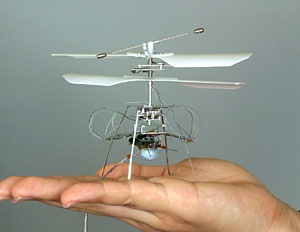The company hopes that the tiny aviation robot, or the smallest and lightest helicopter in the world, can be used as a flying camera in natural disasters
Chuck Ullie, InformationWeek

Direct link to this page: https://www.hayadan.org.il/minicopter.html
In the movie You Live Only Twice, when James Bond took off in the Little Nellie flying machine whose parts were brought to Japan by Q and his assistants in four suitcases, it was hard to believe that the tiny one-seater helicopter was actually flying - but as we know, the camera doesn't lie. 34 years later, Seiko Epson presents a prototype for an even smaller and even more exciting flying machine. But this time it is a useful invention for everything and not a cinematic stunt.
With a weight of 10 grams and a length of 70 millimeters, the tiny aircraft was recently revealed as the lightest and smallest robotic helicopter in the world. The company hopes that it will be used as a "flying camera" in natural disasters. The development of the robot lasted for three years, but Alistair Bourne, the director of marketing communications, refuses to disclose the financial investment. According to Bourne, the Japanese company developed the robot to demonstrate and publicize its technology, which includes four compact, low-energy ultrasonic motors that each vibrate 300,000 times per second. "We weren't thinking about a specific product or any practical application, we just wanted to demonstrate our ability" explains Bourne. "Many companies that will see the prototype will already come up with ideas for possible uses."
Osamu Miyazawa, an engineer at Seiko Epson, says that the robot is a continuation of the company's previous inventions in the field - which began with Munsia, the world's smallest micro robot that was introduced in 1993 and entered the Guinness Book of Records. The main challenge was to develop an engine that would be small and light on the one hand - and produce enough energy on the other. "We had to achieve an ideal balance between weight, dimensions and power." Propulsion of the prototype is carried out by means of a cable connected to an electric generator, because no battery is light enough for the craft to fly. The prototype includes a PC with a Windows operating system, in which the software developed by Epson for directing the robot is installed.
"We tried to connect a sensor or a camera to the robot," says Miyazawa. "The robot can be used, for example, for home or office security needs. It can be programmed to fly independently around the building and detect intruders using the sensor. Another idea is home supervision while on vacation. The pictures taken by the robot can be viewed on the cell phone."
"Another possible application is in natural disasters such as earthquakes," notes Bourne. "The robot can hover over disaster areas that are too dangerous for humans to access. Another option is supervision of children playing in the yard - the parents can watch them from inside the house."
A helicopter weighing 75 grams
Alex Doron
In Australia, helicopters have been developed that have been dubbed the "next generation of autonomous helicopters": this is a helicopter without a pilot, whose purpose is to operate in areas that are dangerous for humans. The helicopter has an advanced brain (a computer, of course), which runs on unique software, and communication and satellite navigation systems (GPS), which give it, according to the developers, "intelligent abilities that were impossible in the past."
The team from the CSIRO company that worked on the development of "Mantis", the helicopter's code name, stated that the helicopter will be able to reach the target area, and after completing its mission, will be able to return to home base on its own.
And what are the tasks assigned to the helicopter? Assistance in the rescue of victims of maritime disasters, surveillance and photography of remote power plants and oil pipelines, aerial mapping and photography (also in XNUMXD), flights to areas affected by forest fires for the purpose of coordinating operations to prevent their spread, inspection of buildings and bridges at risk of collapse, supervision and direction of traffic on roads, and of course, applications military
Dr. Peter Cork, the chief scientist at CSIRO, told Ma'ariv that the abilities given to the mantis are similar to those of UAVs. The helicopter, whose skeleton is made of a magnesium mixture, is equipped with sensors, two tiny cameras and state-of-the-art micro-electromechanical systems. The height of the helicopter is half a meter, its length is less than 1.50 meters and it weighs only 75 grams (less than a cell phone). The Australian military is already showing interest in him.
The robotics expert
For information on the InformationWeek website
https://www.hayadan.org.il/BuildaGate4/general2/data_card.php?Cat=~~~736720218~~~65&SiteName=hayadan
